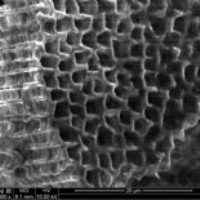A team of scientists from Lockheed Martin and Rice University has developed a process to extract manifold superior-performance anodes from single silicon wafers.

A sponge formed from a solid wafer of silicon helps the material realize its potential to hold 10 times the amount of lithium ions than current materials used in rechargeable batteries. The material was developed by Rice University and Lockheed Martin. (Photo by Madhuri Thakur)
The process enables the use of silicon in place of graphite as an anode in rechargeable lithium-ion batteries, thus paving the way to develop more powerful and durable batteries for use in electric vehicles and commercial electronics. This process involves the electrochemical extraction of Swiss cheese-like silicon sponges from wafers. These sponges absorb over four folds their weight in lithium.
The study findings have been published in Chemistry of Materials, a journal of the American Chemical Society.
Silicon gets expanded when it soaks up lithium ions. On the other hand, this sponge-like structure allows silicon to expand internally without affecting the performance of batteries, according to the research team. The potential of these silicon sponges with 12-µm-depth, 1-µm-width pores for batteries was reported at Rice's Buckyball Discovery Conference in 2010 by Rice scientists, Sibani Lisa Biswal, Madhuri Thakur and Michael Wong, and a Lockheed Martin Fellow, Steven Sinsabaugh. However, Thakur saw a chance for improvement because the solid silicon substrate had no role in soaking up lithium.
In the latest work, the research team found that the electrochemical etching process utilized for making pores is also able to detach the substrate from the sponge, thus allowing the substrate to be reused for more sponge production. This separation also leads to the elimination of a factor that limits the quantity of lithium that can be soaked up. The team was able to extract at least four films from a typical 250-µm-thick wafer.
The research team also discovered a method to increase the depth of the pores to 50 µm. To increase conductivity, the team soaked the silicon sponges in pyrolyzed polyacrylonitrile (PAN), a conductive polymer binder. The resulting tough film can be connected to a current collector and positioned in a battery setup, thus creating a functioning lithium-ion battery with 1,260 mAh/g discharge capacity.
The team compared the performance of batteries utilizing its film prior to and after the PAN-and-bake treatment. Batteries using untreated films had an initial discharge capacity of 757 mAh/g, which declined quickly after the second charge-discharge cycle and totally failed by cycle 15. The treated film demonstrated increased discharge capacity in the first four cycles and remained at the same level through 20 cycles.
The team is working on ways to improve the count of charge-discharge cycles.
Disclaimer: The views expressed here are those of the author expressed in their private capacity and do not necessarily represent the views of AZoM.com Limited T/A AZoNetwork the owner and operator of this website. This disclaimer forms part of the Terms and conditions of use of this website.